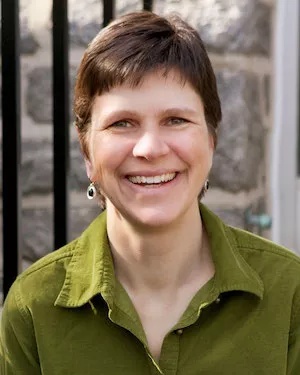NSF Grant Will Measure Impact of Physics Course Built for Life Science Majors

Professor of Physics Catherine Crouch, Senior Laboratory Lecturer Mary Ann Klassen, and Visiting Assistant Professor of Physics Benjamin Geller ‘01 at a circuit board that is meant to represent a neuron.
Thanks to a newly awarded National Science Foundation grant, Professor of Physics Catherine Crouch and Visiting Assistant Professor of Physics Benjamin Geller ’01 are hoping to enhance the authentic connections between physics and biology.
The $221,000 grant over three years will measure how well students taking the Introductory Physics for Life Science (IPLS) course, primarily sophomores and juniors, transfer ideas learned in their courses to other scientific environments.
“It has been really exciting to see how much enthusiasm there is nationally for improving physics education for life science students,” says Crouch. “I hope that the work we do with this grant will help both improve our own courses and encourage faculty around the country to consider teaching physics to life sciences with a biological focus.”
A growing national interest in the design, implementation, and assessment of IPLS courses was part of the reason that Crouch initially launched this curriculum at the College in 2008, and why she and Geller sought the grant.
Geller and Crouch hope the study addresses two central questions about IPLS – do IPLS students leverage physics skills in their later biology coursework? And do they view physics as more relevant and connected to their biology and chemistry coursework as a result of having taken IPLS?

“We’re hoping some of the skills they develop are valuable in their later work and research experiences,” says Professor of Physics Catherine Crouch.
One example of how the course aims to build on student’s experiences in biology and chemistry is by having students build circuit boards that are meant to represent a neuron. There are billions of neurons in the human body, and the beautiful tangle of circuitry allows cells in the body to transmit nerve impulses to the brain.
“A number of students come to the course having learned in biology that, in order for a nerve signal to successfully and quickly propagate down a long axon (part of the neuron), the voltage difference across the neuron membrane must be ‘replenished’ at periodic locations along the axon's length,” says Geller. “This is a really important idea, because diseases such as multiple sclerosis are characterized by an inability for such signals to propagate effectively.”
The circuit board is just one of the topics explored. According to Geller, every introductory physics topic in the IPLS course is built around a central authentic biological question. Among other subjects, students study how molecules move around the cell, how organisms remain biomechanically stable, and how human vision works.
Enthusiastic about the work they do with IPLS, Crouch and Geller are also eager to learn if their anecdotal experience matches up with the research results of this three-year study.
In previous research, they looked at the effects the course had on interest and attitudes about physics, says Max Franklin ’19, an honors physics and linguistics major from Rochester, N.Y. who worked on the research with Crouch and Geller. “We found that while most courses tend to make interest and attitudes decline over the semester, our course caused them to hold steady," says Franklin. Many of their hundreds of IPLS students over the last decade have told them they see more connections between physics and biology after taking the physics course; they want to find out if this is true for the majority of students and want to make the material meaningful to students in their future careers.
“We’re hoping some of the skills they develop are valuable in their later work and research experiences,” says Crouch. “But we also hope seeing the relevance of physics to the biology that already interests them will help them deepen their interest in physics. One of the wonderful things about Swarthmore students is they really love getting at that deep understanding of why things work the way they do.”
Swarthmore is investing in its vibrant intellectual culture. Learn how at lifechanging.swarthmore.edu.



